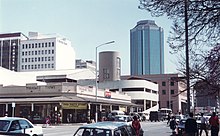Reserve Bank of Zimbabwe
| Headquarters | Harare , Zimbabwe |
| founding | 1956 |
| country | Zimbabwe |
| currency | |
| ISO 4217 | ZWL |
| Currency reserves | US $ 90 million (2018) |
| Website | |
| List of central banks | |
The Reserve Bank of Zimbabwe (RBZ) is the central bank of Zimbabwe , headquartered in Harare .
building
For over 4 decades, the RBZ worked from its main building on Samora Machel Avenue in Harare. A competition to design the new main building was held in the late 1980s and the winning design was from Clinton & Evans and Architects . They also designed the Reserve Bank of Malawi building . Construction of the new RBZ building began in 1993 and was fully completed in 1997. On May 31, 1996 the building was officially opened by the then Zimbabwean President Robert Mugabe . It is the tallest in Zimbabwe with a height of around 120 meters and has 28 floors.
history
The banking business is going to the Reserve Bank of Rhodesia and Nyasaland (1956-1963) back after the collapse of the Federation of Rhodesia and Nyasaland was dissolved 1,963th Prior to 1956 there was the Central Currency Board , which was founded in 1938 as the Southern Rhodesia Currency Board . Their task was to provide the Rhodesian currency, which was fully covered and pegged to the British pound . This was also the currency of Southern Rhodesia (today Zimbabwe), Northern Rhodesia (today Zambia ) and Nyasaland (today Malawi ), which was determined by the Coin and Currency Act of Southern Rhodesia of 1932. The Reserve Bank of Rhodesia, which became the Reserve Bank of Zimbabwe after the country was renamed, has continued its previous function even after a number of changes in its sovereignty and government structure in Rhodesia and Zimbabwe.
From the mid-2000s onwards, Zimbabwe was exposed to hyperinflation , which had been triggered by increased and state-ordered banknote printing by the Reserve Bank of Zimbabwe. In 2008 the inflation rate reached 98% per day. At the same time, the abolition of the central bank was also discussed because it had failed in its role. The use of the Zimbabwean dollar as the official currency was practically discontinued on April 12, 2009 and was replaced by a number of foreign currencies, including the euro , the US dollar and the South African rand . The Reserve Bank of Zimbabwe also issued banknotes that could be exchanged for US dollars. After a foreign currency shortage in 2019, the government reintroduced the Zimbabwean dollar.
structure
The current law on the Reserve Bank of Zimbabwe (originally the Reserve Bank of Zimbabwe Act of 1964 ) provides for a board of directors and a governor. The governor, assisted by three deputy governors, is responsible for the day-to-day administration and operation of the bank. The governor and his three alternates are appointed by the president for a term of five years, which can be renewed. The governor also acts as the chairman of the board. The Board of Directors consists of three deputies and a maximum of seven other non-executive directors who are supposed to represent key sectors of the economy.
Individual evidence
- ^ Zimbabwe Foreign Exchange Reserves . theglobaleconomy.com. Accessed November 24, 2019
- ↑ Republic of Zimbabwe: Reserve Bank of Zimbabwe Act, section 6, part 1a and b . online at www.rbz.co.zw (English)
- ^ RIP Zimbabwe Dollar. Retrieved December 17, 2019 .
- ^ Zim dollars only: Finance minister Ncube bans foreign currency. June 24, 2019, accessed December 17, 2019 .
- ^ Reserve Bank of Zimbabwe: History . on www.rbz.co.zw (English)
